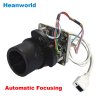Kamalas
n3wb
- Joined
- Jan 25, 2016
- Messages
- 24
- Reaction score
- 5
Sorry for the title as I am at a loss with the terms to explain it.
I am looking at what seem like identical cameras. I notice that one over the other has a slightly different looking lens. One has the lens glass inset while the other appears level with the cover.
What advantage, if any, does one have over the other?

image: http://g01.a.alicdn.com/kf/HTB1T7mELXXXXXcrXXXXq6xXFXXXj/IPC-2MP-IP-Camera-Module-1-2-8-CMOS-IMX322-Hi3516-With-Auto-Iris-Motorized-2.jpg
product: http://www.aliexpress.com/item/IPC-2MP-IP-Camera-Module-1-2-8-CMOS-IMX322-Hi3516-With-Auto-Iris-Motorized-2/32581628117.html

image: http://g02.a.alicdn.com/kf/HTB1Gm_RIVXXXXaqXXXXq6xXFXXXK/2-0MP-1080P-IP-Camera-Main-board-module-CCTV-chipboard-Network-Camera-with-2-8-12mm.jpg
product: http://s.click.aliexpress.com/e/b676qsAM
Related thread:
https://www.ipcamtalk.com/showthread.php/1812-Review-TOP-201-Super-Mini-720P-HD-IP-Cam-(The-Cheapest-IP-Cam-So-Far-
I am looking at what seem like identical cameras. I notice that one over the other has a slightly different looking lens. One has the lens glass inset while the other appears level with the cover.
What advantage, if any, does one have over the other?

image: http://g01.a.alicdn.com/kf/HTB1T7mELXXXXXcrXXXXq6xXFXXXj/IPC-2MP-IP-Camera-Module-1-2-8-CMOS-IMX322-Hi3516-With-Auto-Iris-Motorized-2.jpg
product: http://www.aliexpress.com/item/IPC-2MP-IP-Camera-Module-1-2-8-CMOS-IMX322-Hi3516-With-Auto-Iris-Motorized-2/32581628117.html

image: http://g02.a.alicdn.com/kf/HTB1Gm_RIVXXXXaqXXXXq6xXFXXXK/2-0MP-1080P-IP-Camera-Main-board-module-CCTV-chipboard-Network-Camera-with-2-8-12mm.jpg
product: http://s.click.aliexpress.com/e/b676qsAM
Related thread:
https://www.ipcamtalk.com/showthread.php/1812-Review-TOP-201-Super-Mini-720P-HD-IP-Cam-(The-Cheapest-IP-Cam-So-Far-
